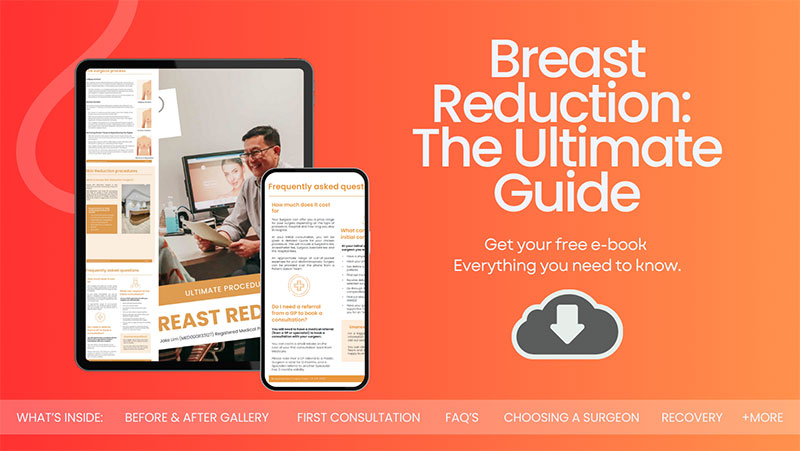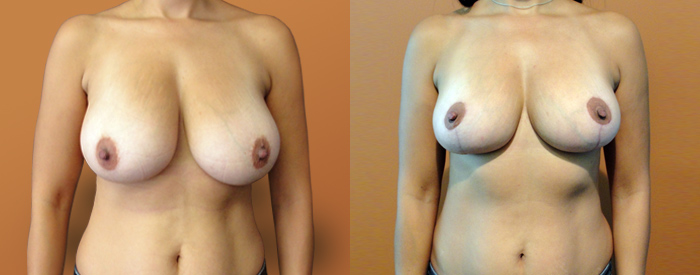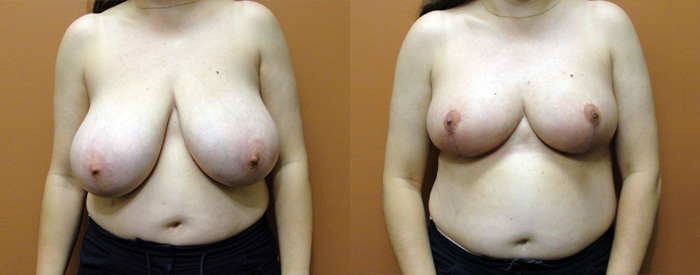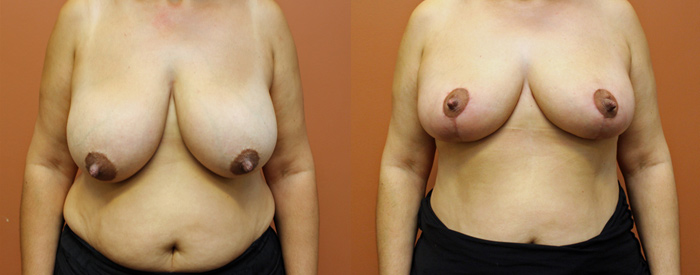Answers to Common Concerns about Reduction Mammoplasty from Dr Jake Lim
Getting a breast reduction (reduction mammoplasty) surgery can cause a mix of emotions and questions. That’s why Sydney Specialist Plastic Surgeon Dr Jake Lim has created this dedicated Breast reduction (reduction mammoplasty) FAQs blog, your ultimate resource for everything you need to know about this procedure. With an array of 25 carefully curated FAQs, Dr Lim aims to cover the whole process, from the initial consideration through to recovery and beyond.
Download Dr Lim’s Free 2024 Breast Reduction Surgery Guide (Reduction Mammoplasty)

1. Can breast reduction (reduction mammoplasty) surgery help alleviate back pain?
Yes, breast reduction (reduction mammoplasty) surgery can significantly help alleviate back pain. Many individuals with overly large breasts experience chronic back, neck, and shoulder pain due to the extra weight they carry. By removing excess breast tissue, fat, and skin, the surgery reduces the physical burden, often resulting in immediate relief from pain and discomfort.
2. What types of anaesthesia are used during breast reduction (reduction mammoplasty) surgery?
Breast reduction (reduction mammoplasty) surgery is performed under general anaesthesia, ensuring that the patient is asleep and pain-free throughout the procedure. Rarely, depending on the extent of the reduction and the patient’s health, local anaesthesia with sedation may be considered. The choice of anaesthesia is determined by the surgeon based on the specific needs and health profile of the patient, ensuring maximum comfort and safety during the surgery.
3. How much pain is involved in breast reduction (reduction mammoplasty) recovery?
The level of pain experienced during breast reduction (reduction mammoplasty) recovery varies among individuals but is generally manageable with prescribed pain medications. Initially, you may experience discomfort, swelling, and bruising, which gradually subsides over the first few weeks. Following Dr Lim’s post-operative care instructions, including rest and limited physical activity, plays a crucial role in minimising discomfort and facilitating a smooth recovery.
4. What kind of support bra should I wear after surgery?
After breast reduction (reduction mammoplasty) surgery, wearing a supportive, non-underwire bra is crucial for comfort and support during the healing process. Dr Lim typically recommends a specific type of surgical or sports bra that provides adequate support without putting unnecessary pressure on the healing tissues. It’s important to wear the recommended bra continuously for the duration specified by Dr Lim to ensure optimal healing and shaping of the breasts.

5. How does breast reduction (reduction mammoplasty) surgery affect breastfeeding?
Breast reduction (reduction mammoplasty) surgery can potentially affect breastfeeding, primarily depending on the technique used and the extent of tissue removal. Some women may experience reduced milk supply or difficulty breastfeeding after the procedure. However, some are still able to breastfeed successfully. Discussing your concerns and future family planning with Dr Lim before the surgery can help tailor the surgical approach to preserve as much breastfeeding capability as possible.
6. Can I have breast reduction (reduction mammoplasty) surgery before having children?
Yes, you can have breast reduction (reduction mammoplasty) surgery before having children, but it’s important to discuss your future pregnancy plans with Dr Lim. Pregnancy and breastfeeding can significantly change breast size and shape, potentially affecting the long-term results of the surgery. While having the surgery before children does not preclude you from breastfeeding, it’s important to weigh the benefits of the surgery against the potential impact on future pregnancies.
7. Will I lose sensation in my nipples after breast reduction (reduction mammoplasty) surgery?
There is a possibility of experiencing changes in nipple sensation after breast reduction (reduction mammoplasty) surgery, ranging from increased sensitivity to reduced or lost sensation. These changes may be temporary, with sensation returning gradually over months. Permanent sensation loss in the nipples, although rare, can occur. The risk varies depending on the surgical technique used and the extent of the reduction.
8. How does breast reduction (reduction mammoplasty) impact future mammograms?
Breast reduction (reduction mammoplasty) surgery can impact how mammograms are performed, as the removal of breast tissue and potential scarring may affect the images. It’s important to inform your mammogram technician about your surgery so they can adjust their techniques accordingly. Despite these adjustments, mammograms remain an effective tool for breast cancer screening in patients who have undergone breast reduction (reduction mammoplasty).
9. Can breast reduction (reduction mammoplasty) surgery affect my ability to breastfeed in the future?
Breast reduction (reduction mammoplasty) surgery may affect your ability to breastfeed, with some women experiencing challenges in milk production or delivery. The impact largely depends on the surgical technique used and how much tissue is removed. If preserving the ability to breastfeed is important to you, discuss this with Dr Lim prior to surgery to explore techniques that minimise the risk to milk ducts and nerves.
10. What are the chances of needing a revision surgery?
The need for revision surgery after breast reduction (reduction mammoplasty) is relatively low but can occur. Reasons for revision may include dissatisfaction with the initial results, asymmetry, or changes in breast size due to weight fluctuations, pregnancy, or ageing. Discussing your expectations and concerns with Dr Lim before the initial surgery can help minimise the likelihood of requiring a revision.
11. How long will the results of the surgery last?
The results of breast reduction (reduction mammoplasty) surgery are generally long-lasting, providing patients with relief from physical discomfort. Factors such as significant weight fluctuations, hormonal changes, pregnancy, and the natural ageing process can affect the size and shape of the breasts over time. Maintaining a stable weight and a healthy lifestyle can help preserve the outcomes of the surgery.

12. Can breast reduction (reduction mammoplasty) surgery be combined with other procedures?
Yes, breast reduction (reduction mammoplasty) surgery can often be combined with other procedures to achieve different results. Common combinations include a breast lift (mastopexy) to address sagging and improve breast shape, tummy tuck (abdominoplasty) for a more contoured abdomen, or liposuction to remove excess fat from specific areas. Combining surgeries can mean a single recovery period, but it’s important to discuss the risks and benefits with Dr Lim.
13. How do I choose the right surgeon for my breast reduction (reduction mammoplasty)?
Choosing the right surgeon for your breast reduction (reduction mammoplasty) is important. Look for a plastic surgeon with extensive experience in breast surgeries. Research their qualifications and review before-and-after photos of their work. During consultations, assess how well the surgeon understands your goals and explains the procedure, risks, and recovery process. A good rapport and clear communication are essential for a successful outcome.
14. What questions should I ask during my consultation?
During your consultation, ask about the surgeon’s qualifications, experience with breast reduction (reduction mammoplasty) surgery, and the techniques they recommend for you. Inquire about the risks, recovery process, potential impact on breastfeeding and nipple sensation, and how they handle complications. Ask to see before-and-after photos of previous patients. Understanding the costs, including what is covered by insurance, is also important.
15. Is breast reduction (reduction mammoplasty) surgery covered by Medicare Australia?
In Australia, breast reduction (reduction mammoplasty) surgery may be covered by Medicare if it’s deemed medically necessary, such as for alleviating chronic pain or other health issues caused by large breasts. Specific criteria must be met, and a referral from a GP or specialist is required. Private health insurance may cover additional costs, depending on the policy. It’s advisable to consult with Dr Lim’s team and insurance provider for detailed information.
16. What are the signs of complications after breast reduction (reduction mammoplasty) surgery?
Signs of complications after breast reduction (reduction mammoplasty) surgery include excessive swelling or bruising, severe pain not relieved by medication, redness and warmth around the incision sites indicating infection, unusual discharge or foul odour from the incisions, and fever. If you experience any of these symptoms, contact Dr Lim immediately for assessment and treatment.
17. What lifestyle changes should I consider after breast reduction (reduction mammoplasty) surgery?
After breast reduction (reduction mammoplasty) surgery, adopting a healthy lifestyle can help maintain your results and overall well-being. This includes maintaining a stable weight through a balanced diet and regular exercise, wearing supportive bras, especially during physical activities, avoiding smoking as it can impair healing and affect skin quality, and protecting your skin from excessive sun exposure to minimise visible scarring.

18. How does weight gain or loss affect the results of breast reduction (reduction mammoplasty) surgery?
Significant weight gain or loss after breast reduction (reduction mammoplasty) surgery can impact the size and shape of your breasts, potentially altering the results. Weight gain can cause the breasts to increase in size, while weight loss might lead to additional sagging or loss of fullness. To maintain the results of your surgery, it’s advisable to keep a stable weight through a healthy lifestyle.
19. How does ageing affect the results of breast reduction (reduction mammoplasty) surgery?
As you age, natural changes in skin elasticity and body composition can affect the appearance of your breasts, even after reduction surgery. Over time, you may notice increased sagging or changes in breast shape. While the relief from physical symptoms like back pain is typically permanent, cosmetic results may evolve. Regular follow-ups with Dr Lim can help address any concerns that arise with ageing.
20. Can breast reduction (reduction mammoplasty) surgery help improve posture?
Yes, breast reduction (reduction mammoplasty) surgery can help improve posture. Large, heavy breasts can pull the body forward, leading to a hunched posture and chronic back, neck, and shoulder pain. By reducing the weight and size of the breasts, the surgery can alleviate this strain, making it easier to maintain good posture.
21. How long do I need to wait before I can see the final results?
The final results of breast reduction (reduction mammoplasty) surgery become apparent within 6 to 12 months after the procedure. Initially, swelling and bruising are common, which gradually subside over the first few weeks. As the healing process continues, the breasts will settle into their new shape and position. It’s important to follow Dr Lim’s post-operative care instructions and attend all follow-up appointments to ensure the best possible outcome and monitor the progress of your results.
22. What are the alternatives to breast reduction (reduction mammoplasty) surgery?
Alternatives to breast reduction (reduction mammoplasty) surgery include non-surgical options like physical therapy to address back and neck pain, weight loss to naturally reduce breast size if overweight, and wearing specially designed supportive bras to alleviate discomfort. For those seeking a less invasive approach to managing large breasts, these alternatives may provide relief, though the results may not be as significant or immediate as surgical intervention.
23. How does breast reduction (reduction mammoplasty) surgery differ for older patients?
Breast reduction (reduction mammoplasty) surgery for older patients may require special considerations due to factors like decreased skin elasticity, slower healing, and the presence of comorbidities that could affect surgery and recovery. Dr Lim may adopt different techniques to minimise scarring and ensure the best possible aesthetic and functional outcomes. Additionally, the goals of surgery might differ, focusing more on comfort and health benefits rather than cosmetic appearance alone. A thorough pre-operative assessment is crucial to tailor the procedure to the specific needs of older patients.
24. Can breast reduction (reduction mammoplasty) surgery be reversed?
Breast reduction (reduction mammoplasty) surgery is considered permanent and cannot be easily reversed. The procedure involves the removal of breast tissue, fat, and skin, which cannot be restored to its original state. While breast implants can be used to increase breast size after reduction, the results may not replicate the breasts’ original appearance or feel. It’s important to thoroughly discuss your goals and expectations with Dr Lim before undergoing breast reduction (reduction mammoplasty) to ensure it aligns with your long-term desires.
25. How do I maintain my results after breast reduction (reduction mammoplasty) surgery?
To maintain the results of your breast reduction (reduction mammoplasty) surgery, it’s important to lead a healthy lifestyle. This includes maintaining a stable weight, as significant weight fluctuations can affect breast size and shape. Regular exercise can help you stay fit and support overall body contour. Wearing supportive bras, especially during physical activities, can help preserve the surgery’s aesthetic outcomes. Additionally, follow any specific advice from Dr Lim regarding breast health and annual check-ups to monitor your results over time.
Further Reading about Breast reduction (reduction mammoplasty) Surgery with Dr Jake Lim
- Read Dr Jake Lim’s Blog about Breast reduction (reduction mammoplasty) Surgery (Reduction Mammoplasty): Techniques and Approaches
- Read Dr Jake Lim’s Blog about Breast reduction (reduction mammoplasty) Complications (Reduction Mammoplasty)
- Read Dr Jake Lim’s Blog about Breast reduction (reduction mammoplasty) vs Breast Lift
- Read Dr Jake Lim’s Blog about What Is Normal Recovery After Breast reduction (reduction mammoplasty) Surgery?
- Read Dr Jake Lim’s Blog about Does Medicare Cover Breast reduction (reduction mammoplasty) Surgery?
- Read Dr Jake Lim’s Blog about Liposuction Breast Reduction Mammoplasty
Medical References about Breast reduction (reduction mammoplasty)
- Long-term outcomes of breast reduction (reduction mammoplasty) surgery – ScienceDirect
- Study Supports Benefits of Breast reduction (reduction mammoplasty) in Teens and Young Women
- Predictive risk factors of complications in reduction mammoplasty-analysis of three different pedicles
- Evaluation of Factors Related to Postoperative Complications in Patients Who Underwent Reduction Mammoplasty
- Long-term follow-up and patient satisfaction after reduction mammoplasty




